The IQ Bell Curve Meme
Lessons from an imperfect but revealing meme about opinions and wisdom 🔔
Hi!
Welcome to issue #18 of Light Gray Matters. Today’s topic is extremely niche, but, I think, quite interesting: we’ll analyze a single image that I’ve seen circulating on the interwebs. It’s a meme that is sort of annoying in the way it’s executed, but to me, it encodes a deep truth about how the world works.
Behold the IQ Bell Curve meme, a.k.a. the Midwit meme:1
This is the blank version. A complete version involves each character — the stupid one, the middle one (the “midwit”) and the smart one — speaking a line of dialogue. The joke comes from the stupid person and the smart person saying exactly the same thing.
For example, about productivity:
There are several things I want to say about this.
First: it’s… a meme, so don’t take it too seriously. As I said, there are many reasons to dislike the way it’s done:
it assumes that holding opinions is strongly associated with intelligence, or more specifically, IQ scores — which is at best a very imperfect way to understand people, and at worst completely wrong
it is pretty dismissive of people with average intelligence, yet it makes clear that the vast majority of people fall into that category
so, to enjoy this meme, you need to believe you’re in the smart category, which you’re likely to do if you believe the stupid/smart opinion
it assumes the opinions themselves follow a bell curve — which is probably wildly untrue in most cases
Despite these problems, the meme does point to a true and interesting pattern in society. The pattern is this: an opinion can be good even if, to most people, it looks like it’s bad. An opinion can be held by particularly smart people even if normal people associate it only with stupid people.
Actually, before we dive deeper, let’s replace “smart” and “stupid” with other terms. The meme is more powerful if we consider the x-axis as a measure of… well, let’s say “wisdom.” Wisdom is difficult to define, but I’ll try anyway: it’s a combination of intelligence, experience,2 education, and good judgment. It’s a generic way to describe someone as “good” in some sense.
The further you are on the right, the wiser you are.3 So the meme suggests that very wise people can hold opinions that people of average wisdom assume only unwise people would hold.
And therein lies the problem.
If you are a person of average wisdom and you see some anonymous rando in the internet say “the laws are dumb,” how likely are you to believe it is a very enlightened sage saying this? About 0% likely.
In fact, whether we’re talking about IQ or wisdom, the most interesting property of this meme is that the opinions of people to your right are necessarily opaque to you. If you were able to understand and accept the reasoning of smarter or wiser people, that would imply you’re smarter/wiser than you let on… and that you’re actually further along the x-axis.
So wherever you are on the axis, reality will look like this to you:
We don’t understand the wiser people. We accept that they exist, maybe. But only in an abstract sense. We always feel that we have the best opinions, since otherwise we would adopt those other, better opinions (or at least accept that we don’t know what’s the best).
So when we encounter a point of view that differs from ours, we often assume it goes in the “obviously wrong” bin.4
The bell curve meme is useful because it reminds us that sometimes, a wise, well-reasoned opinion can deceptively look like a stupid, superficial one. And that’s really hard to accept!
The key thing here is that the reasoning underlying the stupid and the wise opinions is very different. The wise person has a lot of experience and knowledge allowing them to think what they think with confidence. The stupid person just randomly stumbled upon the idea, maybe because it’s a simple one, or because they’re following their natural impulses.
When they agree, it can be because simplicity or following your natural impulses is the right thing to do.
Or it can be a coincidence. The bell curve meme doesn’t tell us that this stupid/wise agreement is particularly common. Maybe most cases don’t look like this at all.
But I do suspect that it’s more common than we think. I see the meme come up a lot on Twitter these days. The pattern is good at describing many social phenomena:
The lower classes don’t care what we think of them, the middle class tries to look classy, the upper classes don’t care what we think of them
Children want to play, adults think play isn’t serious, wise adults are playful
Stupid people think intelligence really helps, somewhat smart people think intelligence doesn’t matter, really smart people think intelligence really helps
And so on. Scott Alexander has a great piece from 2010 about a similar pattern, which he calls meta-contrarianism. He doesn’t say that the contrarian (middle) or meta-contrarian (right) opinions are always right or wrong, though. Which opinion is correct always depends on the question.
So it goes with the IQ bell curve meme. It’s a joke, mostly, and it’s often wrong, misleading, or just plain annoying. Yet if it can remind us that a seemingly stupid opinion can in fact be wise, then it serves a good purpose.
With that, I wish you a nice equinox and I remain
Yours in attempting to grow wiser,
Étienne
On Twitter: Emojyptian Fun
I did a lot of extremely state-of-the-art research (i.e. going through the Wikipedia list of hieroglyphs) to create a fairly comprehensive set of pairings between Egyptian hieroglyphs and emoji. Are emoji
It features my new favorite hieroglyph: 𓀬 (man on two giraffes).

Then on the same day I started learning the Korean Hangul so I guess my Twitter account is about writing systems now


See knowyourmeme.com for a bit of history about this meme.
Here’s an example of the meme with something different and specific: pain experienced.
Though now we’re not necessarily dealing with a clean normal curve like IQ anymore. The wisdom curve can look very different depending on what’s being discussed.
If we’re talking about laws, the normal curve sounds about right — the vast majority of people think the law must be followed, while only a small minority of either wildly unwise or vastly enlightened people think (thanks to either their recklessness or their erudition in ethical philosophy) that it’s better not to. But other situations may involve different curves, for instance ones where everyone is at some basic low level of wisdom:
Unless it comes from a trusted source, or if the reasoning is made crystal-clear. But even then, changing our minds is hard.


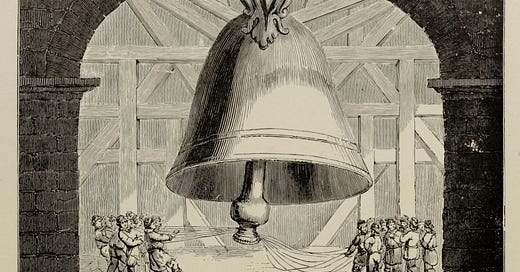



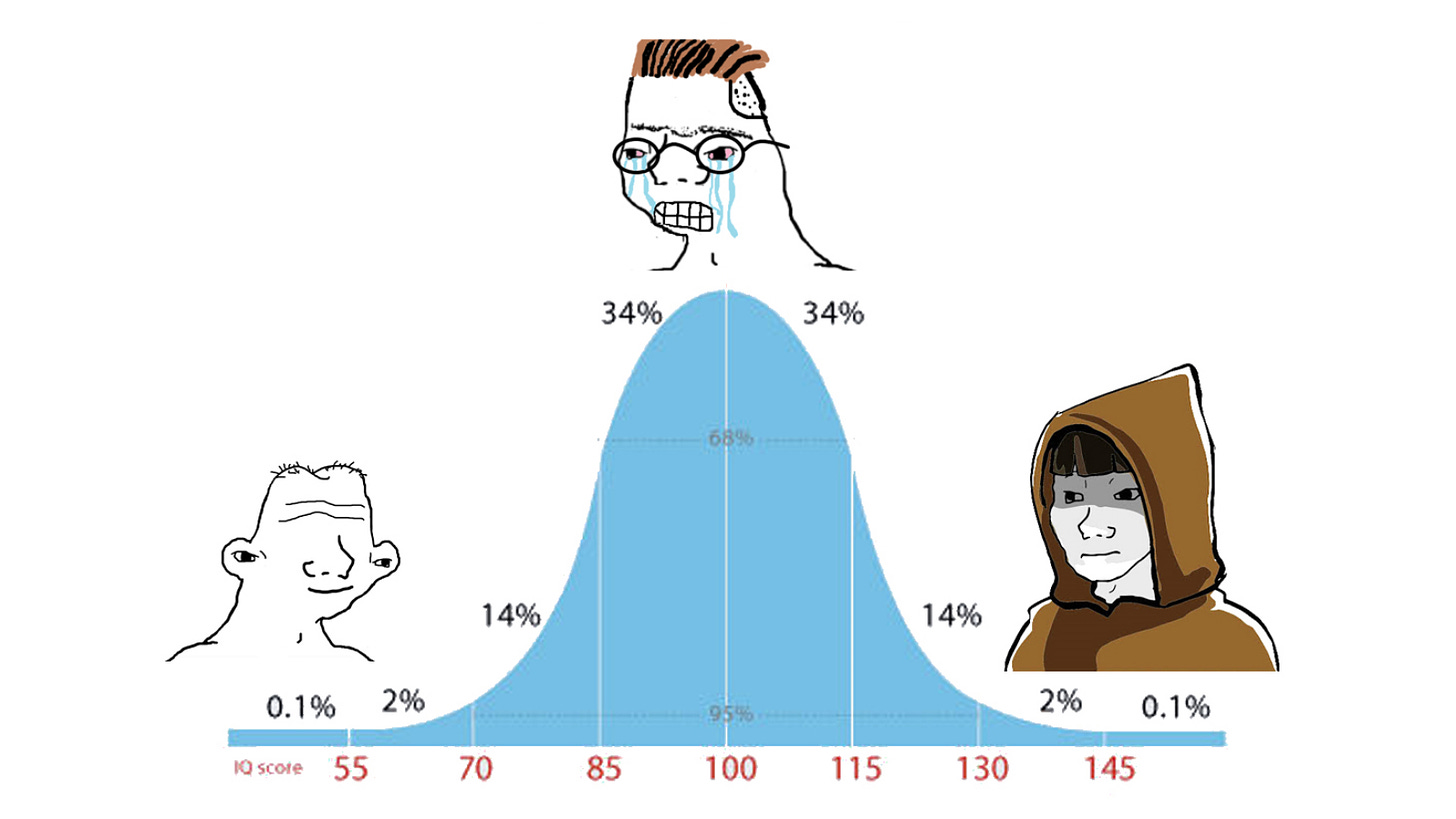
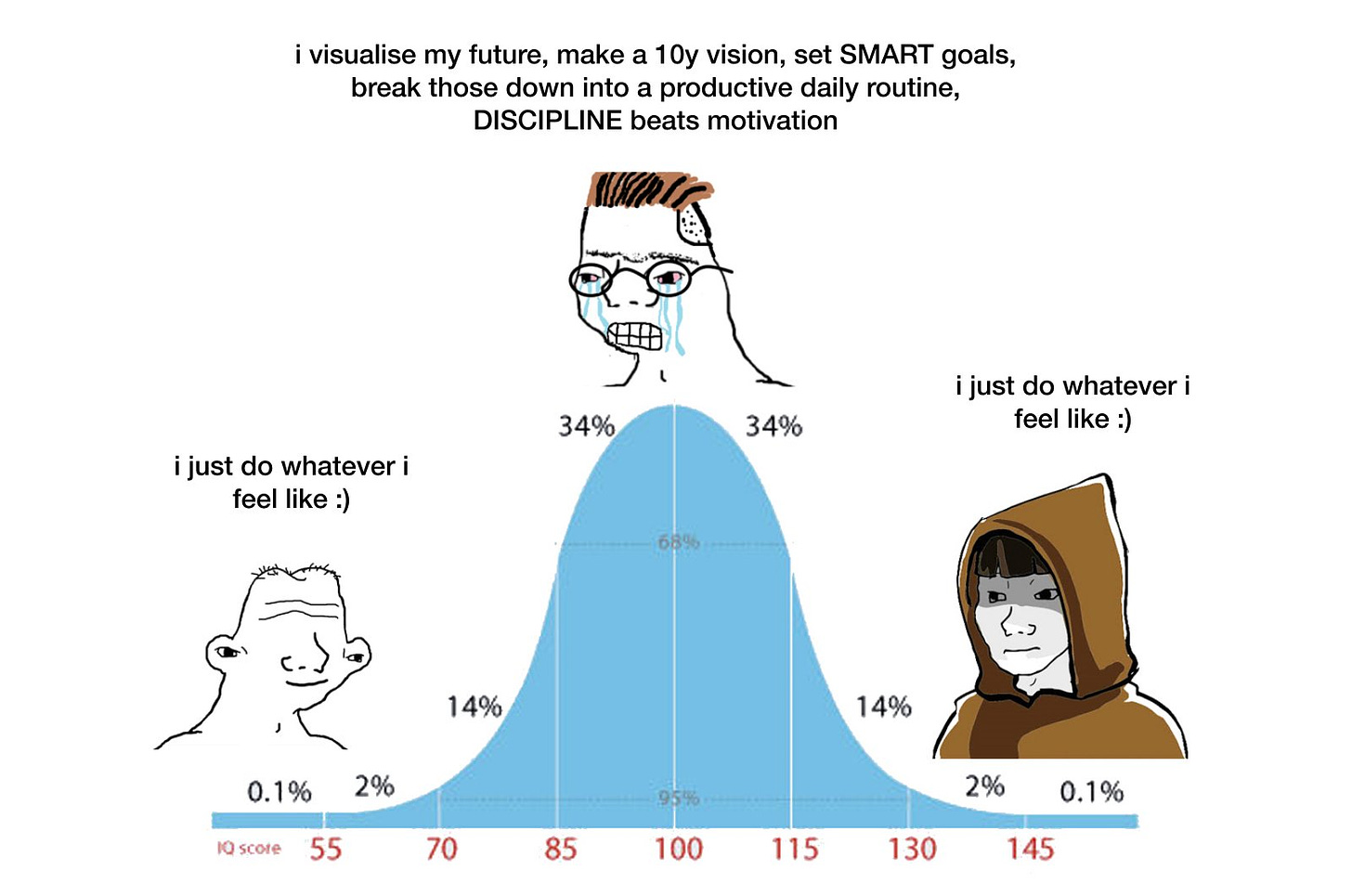
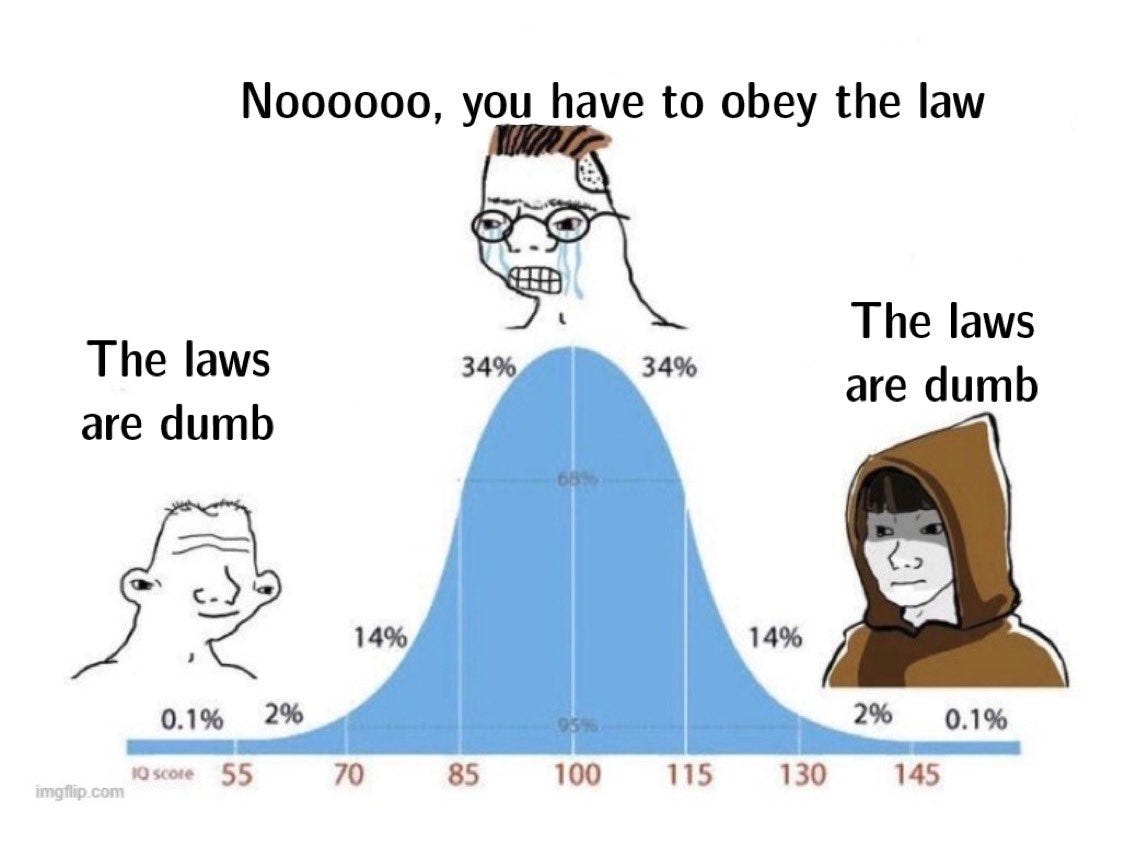


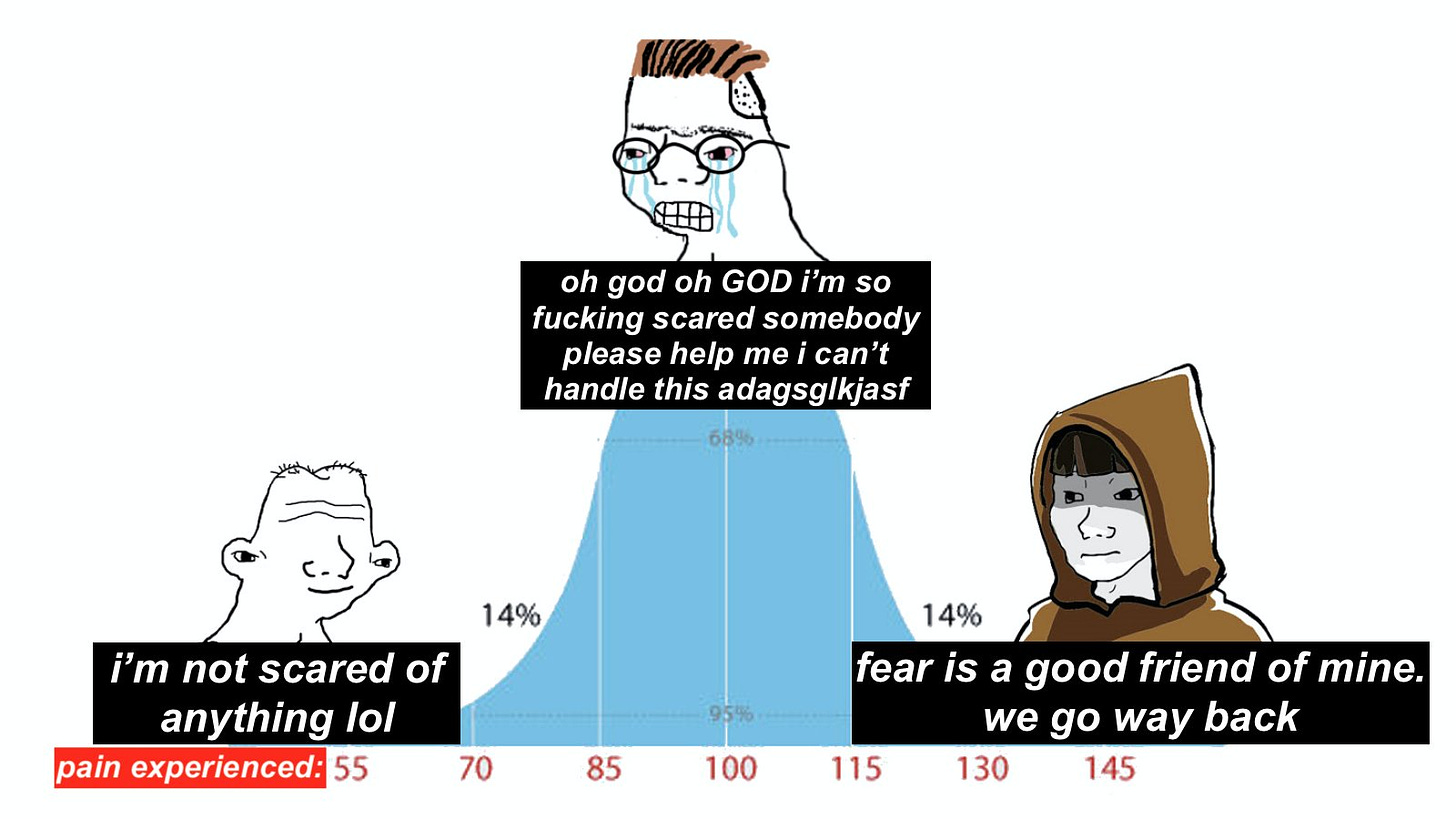
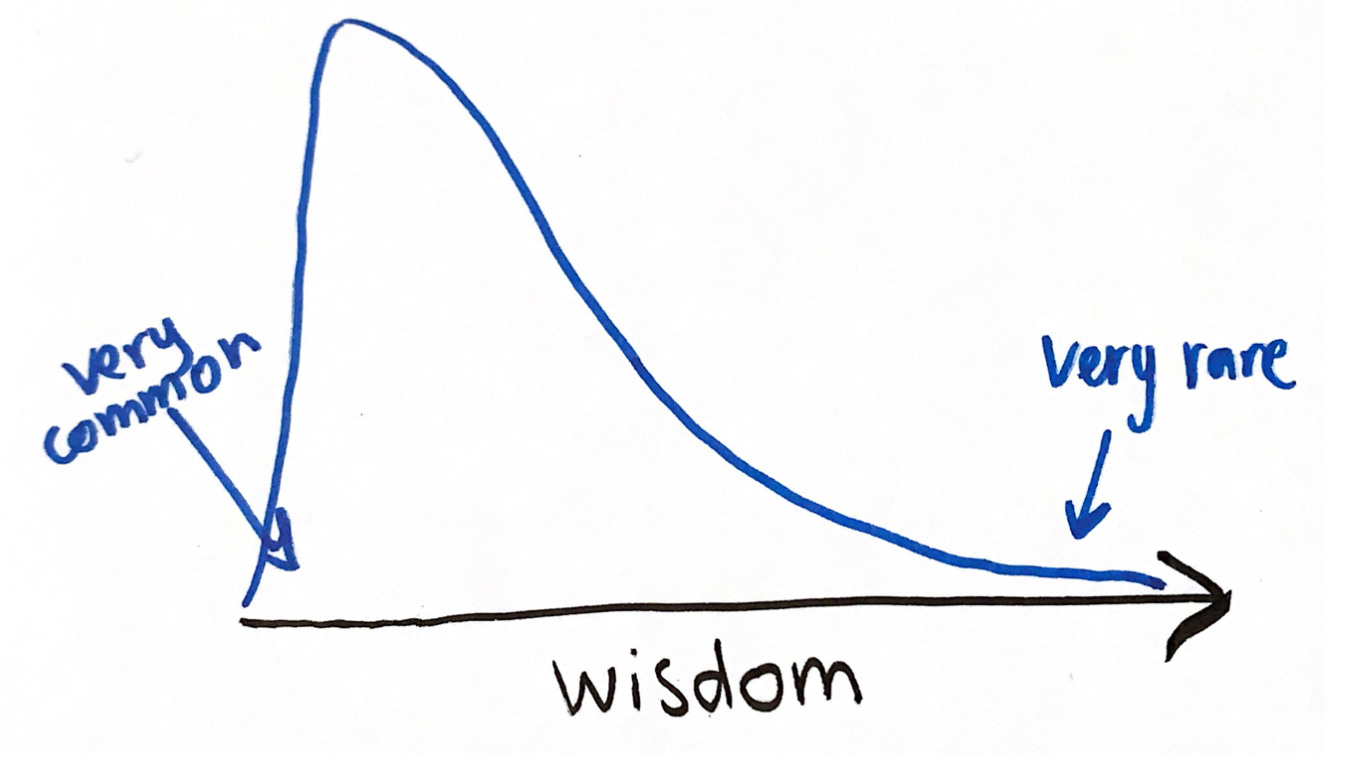
This concept reminds me of an old Jane Addams passage which I like to quote:
"Let us take the example of a timid child, who cries when he is put to bed because he is afraid of the dark. The "soft-hearted" parent stays with him, simply because he is sorry for him and wants to comfort him. The scientifically trained parent stays with him, because he realizes that the child is in a stage of development in which his imagination has the best of him, and in which it is impossible to reason him out of a belief in ghosts. These two parents, wide apart in point of view, after all act much alike, and both very differently from the pseudoscientific parent, who acts from dogmatic conviction and is sure he is right. He talks of developing his child's self-respect and good sense, and leaves him to cry himself to sleep, demanding powers of self-control and development which the child does not possess."
I think this also illustrates a subtler shading to the meme image: the "midwit" is typically not just expressing a conventional belief, but also trying to actively assert said belief as accepted dogma. (And hence it's all the more satisfying to the meme consumer to view themselves as bucking such "dogmatic conviction".)
And now I would like to know what your previous favorite hieroglyph was before you saw man standing on two giraffes.